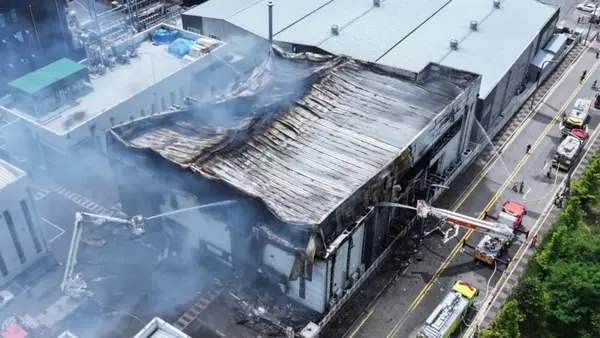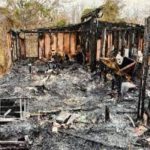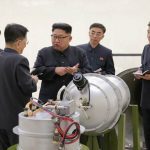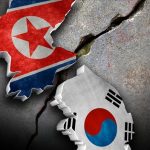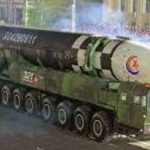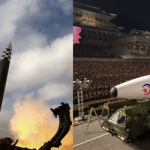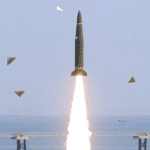A massive factory fire that began after several lithium batteries exploded has killed at least 22 people in South Korea.
The blaze broke out on Monday morning at the Aricell plant in Hwaseong city, about 45km (28 miles) south of the capital Seoul.
Local television footage showed small explosions going off as firefighters sought to put out the fire.
A part of the roof had collapsed.
South Korea is a leading producer of lithium batteries, which are used in many items from electric vehicles to laptops.
Fire official Kim Jin-young said 18 Chinese, one Laotian and two South Korean workers had been confirmed as among the dead.
A final body had yet to be identified.
A further three people were injured – two seriously – out of the 100 who had been working when the fire broke out.
The Aricell factory housed an estimated 35,000 battery cells on its second floor, where the batteries were inspected and packaged, with more stored elsewhere.
Mr Kim said the fire began when a series of battery cells exploded, though it remains unclear what triggered the initial explosions.
He explained it was difficult to enter the site initially “due to fears of additional explosions”.
As a lithium fire can react intensely with water, firefighters had to use dry sand to extinguish the blaze, which took several hours to get under control.
Lithium batteries are at risk of exploding if they are damaged or overheated.
While a fire can be extinguished, it remains at risk of reigniting without warning due to the chemical reaction.
A massive factory fire that began after several lithium batteries exploded has killed at least 22 people in South Korea.
The blaze broke out on Monday morning at the Aricell plant in Hwaseong city, about 45km (28 miles) south of the capital Seoul.
Local television footage showed small explosions going off as firefighters sought to put out the fire.
A part of the roof had collapsed.
South Korea is a leading producer of lithium batteries, which are used in many items from electric vehicles to laptops.
Fire official Kim Jin-young said 18 Chinese, one Laotian and two South Korean workers had been confirmed as among the dead.
A final body had yet to be identified.
A further three people were injured – two seriously – out of the 100 who had been working when the fire broke out.
The Aricell factory housed an estimated 35,000 battery cells on its second floor, where the batteries were inspected and packaged, with more stored elsewhere.
Mr Kim said the fire began when a series of battery cells exploded, though it remains unclear what triggered the initial explosions.
He explained it was difficult to enter the site initially “due to fears of additional explosions”.
As a lithium fire can react intensely with water, firefighters had to use dry sand to extinguish the blaze, which took several hours to get under control.
Lithium batteries are at risk of exploding if they are damaged or overheated.
While a fire can be extinguished, it remains at risk of reigniting without warning due to the chemical reaction.
A massive factory fire that began after several lithium batteries exploded has killed at least 22 people in South Korea.
The blaze broke out on Monday morning at the Aricell plant in Hwaseong city, about 45km (28 miles) south of the capital Seoul.
Local television footage showed small explosions going off as firefighters sought to put out the fire.
A part of the roof had collapsed.
South Korea is a leading producer of lithium batteries, which are used in many items from electric vehicles to laptops.
Fire official Kim Jin-young said 18 Chinese, one Laotian and two South Korean workers had been confirmed as among the dead.
A final body had yet to be identified.
A further three people were injured – two seriously – out of the 100 who had been working when the fire broke out.
The Aricell factory housed an estimated 35,000 battery cells on its second floor, where the batteries were inspected and packaged, with more stored elsewhere.
Mr Kim said the fire began when a series of battery cells exploded, though it remains unclear what triggered the initial explosions.
He explained it was difficult to enter the site initially “due to fears of additional explosions”.
As a lithium fire can react intensely with water, firefighters had to use dry sand to extinguish the blaze, which took several hours to get under control.
Lithium batteries are at risk of exploding if they are damaged or overheated.
While a fire can be extinguished, it remains at risk of reigniting without warning due to the chemical reaction.
A massive factory fire that began after several lithium batteries exploded has killed at least 22 people in South Korea.
The blaze broke out on Monday morning at the Aricell plant in Hwaseong city, about 45km (28 miles) south of the capital Seoul.
Local television footage showed small explosions going off as firefighters sought to put out the fire.
A part of the roof had collapsed.
South Korea is a leading producer of lithium batteries, which are used in many items from electric vehicles to laptops.
Fire official Kim Jin-young said 18 Chinese, one Laotian and two South Korean workers had been confirmed as among the dead.
A final body had yet to be identified.
A further three people were injured – two seriously – out of the 100 who had been working when the fire broke out.
The Aricell factory housed an estimated 35,000 battery cells on its second floor, where the batteries were inspected and packaged, with more stored elsewhere.
Mr Kim said the fire began when a series of battery cells exploded, though it remains unclear what triggered the initial explosions.
He explained it was difficult to enter the site initially “due to fears of additional explosions”.
As a lithium fire can react intensely with water, firefighters had to use dry sand to extinguish the blaze, which took several hours to get under control.
Lithium batteries are at risk of exploding if they are damaged or overheated.
While a fire can be extinguished, it remains at risk of reigniting without warning due to the chemical reaction.
A massive factory fire that began after several lithium batteries exploded has killed at least 22 people in South Korea.
The blaze broke out on Monday morning at the Aricell plant in Hwaseong city, about 45km (28 miles) south of the capital Seoul.
Local television footage showed small explosions going off as firefighters sought to put out the fire.
A part of the roof had collapsed.
South Korea is a leading producer of lithium batteries, which are used in many items from electric vehicles to laptops.
Fire official Kim Jin-young said 18 Chinese, one Laotian and two South Korean workers had been confirmed as among the dead.
A final body had yet to be identified.
A further three people were injured – two seriously – out of the 100 who had been working when the fire broke out.
The Aricell factory housed an estimated 35,000 battery cells on its second floor, where the batteries were inspected and packaged, with more stored elsewhere.
Mr Kim said the fire began when a series of battery cells exploded, though it remains unclear what triggered the initial explosions.
He explained it was difficult to enter the site initially “due to fears of additional explosions”.
As a lithium fire can react intensely with water, firefighters had to use dry sand to extinguish the blaze, which took several hours to get under control.
Lithium batteries are at risk of exploding if they are damaged or overheated.
While a fire can be extinguished, it remains at risk of reigniting without warning due to the chemical reaction.
A massive factory fire that began after several lithium batteries exploded has killed at least 22 people in South Korea.
The blaze broke out on Monday morning at the Aricell plant in Hwaseong city, about 45km (28 miles) south of the capital Seoul.
Local television footage showed small explosions going off as firefighters sought to put out the fire.
A part of the roof had collapsed.
South Korea is a leading producer of lithium batteries, which are used in many items from electric vehicles to laptops.
Fire official Kim Jin-young said 18 Chinese, one Laotian and two South Korean workers had been confirmed as among the dead.
A final body had yet to be identified.
A further three people were injured – two seriously – out of the 100 who had been working when the fire broke out.
The Aricell factory housed an estimated 35,000 battery cells on its second floor, where the batteries were inspected and packaged, with more stored elsewhere.
Mr Kim said the fire began when a series of battery cells exploded, though it remains unclear what triggered the initial explosions.
He explained it was difficult to enter the site initially “due to fears of additional explosions”.
As a lithium fire can react intensely with water, firefighters had to use dry sand to extinguish the blaze, which took several hours to get under control.
Lithium batteries are at risk of exploding if they are damaged or overheated.
While a fire can be extinguished, it remains at risk of reigniting without warning due to the chemical reaction.
A massive factory fire that began after several lithium batteries exploded has killed at least 22 people in South Korea.
The blaze broke out on Monday morning at the Aricell plant in Hwaseong city, about 45km (28 miles) south of the capital Seoul.
Local television footage showed small explosions going off as firefighters sought to put out the fire.
A part of the roof had collapsed.
South Korea is a leading producer of lithium batteries, which are used in many items from electric vehicles to laptops.
Fire official Kim Jin-young said 18 Chinese, one Laotian and two South Korean workers had been confirmed as among the dead.
A final body had yet to be identified.
A further three people were injured – two seriously – out of the 100 who had been working when the fire broke out.
The Aricell factory housed an estimated 35,000 battery cells on its second floor, where the batteries were inspected and packaged, with more stored elsewhere.
Mr Kim said the fire began when a series of battery cells exploded, though it remains unclear what triggered the initial explosions.
He explained it was difficult to enter the site initially “due to fears of additional explosions”.
As a lithium fire can react intensely with water, firefighters had to use dry sand to extinguish the blaze, which took several hours to get under control.
Lithium batteries are at risk of exploding if they are damaged or overheated.
While a fire can be extinguished, it remains at risk of reigniting without warning due to the chemical reaction.
A massive factory fire that began after several lithium batteries exploded has killed at least 22 people in South Korea.
The blaze broke out on Monday morning at the Aricell plant in Hwaseong city, about 45km (28 miles) south of the capital Seoul.
Local television footage showed small explosions going off as firefighters sought to put out the fire.
A part of the roof had collapsed.
South Korea is a leading producer of lithium batteries, which are used in many items from electric vehicles to laptops.
Fire official Kim Jin-young said 18 Chinese, one Laotian and two South Korean workers had been confirmed as among the dead.
A final body had yet to be identified.
A further three people were injured – two seriously – out of the 100 who had been working when the fire broke out.
The Aricell factory housed an estimated 35,000 battery cells on its second floor, where the batteries were inspected and packaged, with more stored elsewhere.
Mr Kim said the fire began when a series of battery cells exploded, though it remains unclear what triggered the initial explosions.
He explained it was difficult to enter the site initially “due to fears of additional explosions”.
As a lithium fire can react intensely with water, firefighters had to use dry sand to extinguish the blaze, which took several hours to get under control.
Lithium batteries are at risk of exploding if they are damaged or overheated.
While a fire can be extinguished, it remains at risk of reigniting without warning due to the chemical reaction.

